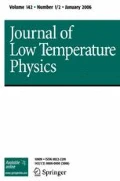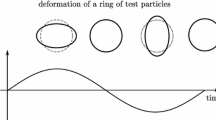Abstract
We report the final results of EDELWEISS-II, obtained with ten 400 g heat-and-ionization cryogenic detectors equipped with InterDigit electrodes for the rejection of near-surface events. Results from fourteen months of continuous operation and a total exposure of 384 kg day are presented. We also present the status of EDELWEISS-III, which will accumulate more than 3000 kg day of data with 40 new 800 g detectors in the coming years.
Similar content being viewed by others
1 The EDELWEISS-II Experiment
The EDELWEISS experiment (Expérience pour DEtecter Les Wimps En Site Souterrain) is searching Dark Matter by the direct detection of WIMPs trapped in the Milky Way halo. The detection is performed through the measurement of the recoil energy produced by the elastic scattering of a WIMP off target nuclei. The main constraints are the extremely low event rate (<1 evt/kg/year) and relatively small deposited energy (in the tens of keV range). The goal of the phase II of the project is to explore wimp-nucleon cross section of a few 10−8 pb, thus requiring a background of less than 10−3 nuclear recoil candidate per kg day above 10 keV.
The EDELWEISS-II setup (see Fig. 1) is located in the Laboratoire Souterrain de Modane in the Fréjus Tunnel highway connecting France and Italy in the Alps. The 1800 m surrounding rock (4800 mwe) reduces the muon flux down to 4 μ/m2/day, ∼106 times less than at the surface. The fast neutron flux in the cavity has been measured to be 10−6 n/cm2/s above 1 MeV.
The outside gamma background is screened by a 20 cm thick lead shielding. All the materials used in the vicinity of the detectors have been tested for their radiopurity. A clean room surrounds the whole experiment and a class 100 laminar flow with deradonised air (<0.1 Bq/m3) is used when mounting the detectors. The low energy neutron background is moderated thanks to a 50 cm of polyethylene. A 100 m2 plastic scintillator muon veto (∼98% coverage) tags residuals muons that could produce neutrons (mostly in the lead shielding). Additional monitoring is performed by a Rn detector, a He3-gas detector for thermal neutrons [1] and a 1 m3 Gd-loaded liquid scintillator for studies of muon-induced neutron [2].
The residual neutron background comes from high energy neutrons produced by muons not tagged by the veto, 238U fission in the lead shielding and by (α,n) reactions in the electronics and cabling.
The experimental volume is about 50 liters allowing the installation of up to 40 kg of detectors in a compact arrangement for self shielding and multiple interaction identification.
EDELWEISS uses high purity Germanium cryogenic detectors with simultaneous measurement of phonon and ionization signals at ∼20 mK. A nucleus recoil produces approximately three times less ionization than an electron recoil does, allowing an excellent event-by-event discrimination between nuclear recoils (induced by WIMPs or neutron scattering) and electron recoils (induced by α, β and γ radioactivity).
The actual limitation of this technique arises from incomplete charge collection for near-surface events (mainly low energy electrons from residual 210Pb, a daughter of radon that is present on all surfaces): because of diffusion, recombination and trapping processes a small fraction of surface events could be miscollected and even mimic nuclear recoil interactions.
The EDELWEISS collaboration has recently developed a new type of detectors, the so-called “ID” (InterDigit) detectors with an active surface event rejection based on a special interdigitized electrodes scheme. The detectors are made from a hyper pure germanium crystal of cylindrical shape with a diameter of 70 mm and a height of 20 mm. Each flat surface is covered with concentric aluminum ring electrodes of 2 mm pitch regrouped in two sets of electrodes connected alternatively by ultrasonic bounding. Two additional plain guard electrodes cover the outer edges of the crystal.
The principle of the surface events rejection is shown in Fig. 2. The field in the bulk is set axial by the two opposite electrodes with the largest differences of potential (the fiducial electrodes) while the field near the surfaces is shaped parallel to the surfaces by the lower values of the so-called veto and guard electrodes. Typical values of biases are ±4 V for the opposite fiducial electrodes, ±1.5 V and ±1 V for the veto and guard ones. Interactions in the fiducial volume give a perfect charge balance on both fiducial electrodes and no signals in the veto and guard electrodes. This redundancy provides a very high rejection efficiency that has been measured at the 10−5 level for surface betas [3].
2 Wimp-Search with EDELWESS-II
A WIMP search was carried out using ten 400-g ID detectors from April 2009 to May 2010. During the whole acquisition period, the cryogenic conditions were maintained stable at 18 mK. Most of the time was devoted to WIMP search (325 days), and a small fraction to gamma and neutron calibrations (10.1 days and 6.4 days). The data were analysed using two independent pipelines which yield consistent results. The average baseline resolutions of heat and fiducial ionization channels were of ∼1.2 keV FWMH and ∼0.9 keV FWHM, respectively. WIMPs interaction candidates were searched among fiducial events in the 90% CL nuclear recoil band. Tagging of coincident events in bolometers and the muon veto allowed to reject neutron-induced recoils. A WIMP- search energy threshold was set a priori to 20 keV, above which the efficiency is independent of the energy. After all cuts, the effective exposure obtained is 384 kg d. The analysis procedures and results are described in details in [4].
In Fig. 3. we show the ionization yield for neutron and gamma calibrations. From the γ-ray calibration we obtain a γ rejection factor of ∼3×10−5. The origin of the six events leaking into the nuclear recoil band is being investigated but we can see on Fig. 5. that the rejection is improved significantly with the new FID detectors without guard rings.
(Color online) Ionization yield (=ionization/recoil energy) Q vs. recoil energy. Left: Neutron calibration (AmBe source). The electronic recoil nominal value Q=1, the 90% CL nuclear recoil band and the lines arising from inelastic neutron scattering at 13.26 keV and 68.75 keV are highlighted. Right: Gamma calibration (133 Ba source, 3.5×105 events). The solid lines represent the average 99.99% rejection line for electron recoils (black), the 90% CL nuclear recoil band (red) and the ionization threshold (green)
Results of the WIMP search are summarized in Fig. 4. Five events are found in the nuclear recoil band: four of them have energies between 20 and 23 keV, and one has 172 keV. All of them are well-reconstructed events, which lie well above the noise level of the detectors. Background studies are still ongoing to fully understand their origin. Upper limits may be derived from the known residual gamma, beta and neutron backgrounds, using calibration data, material radioactivity measurements and Monte Carlo simulation of the detectors. Overall, less than 3 events (90% CL) from known origin are expected. The spin-independent cross-section upper limit for WIMP-nucleon elastic scattering is calculated using the standard Yellin prescription [12] and halo model and parameters (see [4] for details). The best sensitivity obtained by EDELWEISS-II is 4.4×10−8 pb at M=85 GeV.
(Color online) Top: Ionization yield vs. recoil energy obtained in the WIMP search after fiducial cuts. Highlighted in red, the five events found in the nuclear recoil band which are retained as WIMP candidates. Bottom: WIMP-nucleon spin-independent elastic cross-section upper limit at 90% CL vs. WIMP mass obtained in this analysis (cross blue) and recent results from other experiments [5–8] as well as the combined limit obtained with the CDMS experiment [9]. The filled gray area corresponds to SUSY scan from [10, 11]
These data have been also interpreted in the inelastic dark matter scenario. Results are presented in detail in [4].
3 The EDELWEISS-III Project: Setup and Detectors
The Inter-Digit detector technology has proven to be reliable and robust enough to perform direct detection of WIMPs at the highest level of the competition. To go beyond the present performances, a new generation of detectors has been developed with interleaved electrodes covering also the lateral surfaces of the crystal: the Full Inter-Digit (FID). A first series of four detectors has been tested. The combination of an unprecedented mass of 800 g and the FID technology increases significantly the fiducial mass of the detectors to ∼600 g (it was ∼165 g for the ID). In addition to this, the FID800 series benefits from two NTD sensors to have redundancy also in the heat measurement and new surface treatments to increase the surface event rejection [13].
Extensive γ calibrations of the 4 FID800 detectors have been performed at LSM. As an illustration of the important improvement achieved, all 410 000 gammas are rejected.
The goal of the funded EDELWEISS-III project is to install 40 FID800 bolometers in an upgraded setup (cryostat, shieldings, cabling, electronics [14], muon veto) to reduce the background, lower the energy threshold (see [14]) to reach a 3000 kg d exposure in 2012 and a potential WIMP-nucleon cross-section sensitivity at the level of 5×10−9 pb.
References
S. Rosov et at., J. Phys. G (submitted). arXiv:1001.4383
V. Kozlov et al., Astropart. Phys. 34, 97 (2010). arXiv:1006.3098
A. Broniatowski et al., Phys. Lett. B 681, 305 (2009). arXiv:0905.0753
A. Armengaud et al., Phys. Lett. B 702, 329 (2011). arXiv:1103.4070
Z. Ahmed et al., Science 327, 1619 (2010). CDMS
E. Aprile et al., Phys. Rev. C 79, 045807 (2009). arXiv:1104.2549, XENON10-100
G. Angloher et al., Astropart. Phys. 31, 270 (2009). CRESST-II
V.N. Lebedenko et al., Phys. Rev. D 80, 052010 (2009). ZEPLIN-III
Z. Ahmed et al., Phys. Rev. D 84, 011102(R) (2011). arXiv:1105.3377
J. Ellis et al., Phys. Rev. D 71, 095007 (2005)
L. Roszkowski et al., J. High Energy Phys. 07, 075 (2007)
S. Yellin, Phys. Rev. D 66, 032005 (2002)
S. Marnieros et al., AIP Conf. Proc. 1185, 635 (2009)
B. Censier et al., J. Low Temp. Phys. (2012). doi:10.1007s10909-012-0568-9
Acknowledgements
The help of the technical staff of the Laboratoire Souterrain de Modane is gratefully acknowledged. This project is supported in part by the Agence Nationale pour la Recherche under contract ANR-06-BLAN-0376-01, by the Russian Foundation for Basic Research and by the Science and Technology Facilities Council, UK.
Author information
Authors and Affiliations
Corresponding author
Additional information
For the EDELWEISS collaboration.
Rights and permissions
About this article
Cite this article
Juillard, A. Status and Prospects of the EDELWEISS Direct WIMP Search Experiment. J Low Temp Phys 167, 1056–1062 (2012). https://doi.org/10.1007/s10909-012-0512-z
Received:
Accepted:
Published:
Issue Date:
DOI: https://doi.org/10.1007/s10909-012-0512-z








